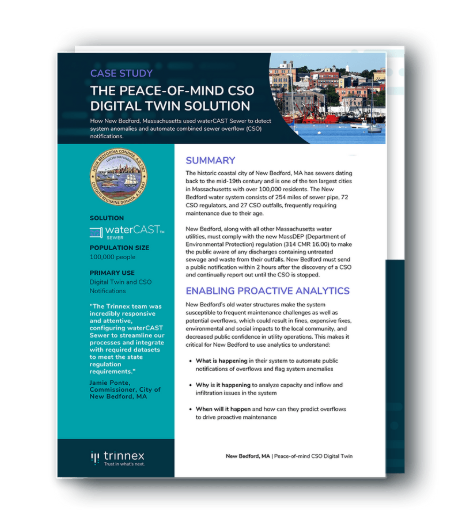Data, today, is more than just a technical asset—it’s a strategic enabler. Water and wastewater utilities face mounting pressure to do more with less, and integrating critical data sources in their processes is the key to unlocking smarter operations.
By combining real-time monitoring, spatial intelligence, and predictive modeling, utilities can enhance decision-making, reduce risk, and improve service delivery. Inspired by Trinnex’s Data Science-as-a-Service (DSaaS) methodology, this article explores the top six data sources every utility should be integrating today.
1. SCADA: Your Real-Time Eyes and Ears
Supervisory Control and Data Acquisition (SCADA) systems are the operational backbone of utilities, continuously monitoring pumps, valves, tanks, and treatment processes.
Why should utilities integrate SCADA?
When SCADA data is siloed, utilities miss out on the broader operational picture. Integration enables early detection of anomalies such as sensor drift or pump inefficiencies, automates alerts, and reduces emergency repairs.
DSaaS Insight: Trinnex’s waterCAST® uses machine learning to flag unusual SCADA patterns, enabling predictive maintenance and reducing downtime.
2. GIS: The Map That Makes Everything Make Sense
Geographic Information Systems (GIS) bring infrastructure to life on a map-pipes, hydrants, valves, meters-all spatially contextualized.
Why should utilities integrate GIS?
When GIS is layered with operational and risk data, utilities can prioritize maintenance based on asset age and condition, visualize service areas, and plan capital projects with spatial intelligence.
DSaaS Insight: Trinnex overlays GIS with risk scores to help utilities identify the assets most likely to fail-before they do.
3. Lab and Sampling Data
Water quality data from labs and field sampling play crucial part in regulatory compliance and public health.
Why should utilities integrate lab and sampling data?
Centralizing lab data allows utilities to track trends in contaminants such as PFAS or lead, automate compliance reporting, and respond quickly to potential health risks.
DSaaS Insight: With waterCAST WQ, utilities can set up alerts for threshold breaches and generate public-facing dashboards to build trust and transparency.
4. Hydraulic and Water Quality Models
Models simulate how systems behave under various conditions such as peak demand, fire flow, or contamination events.
Why should utilities integrate Hydraulic and water quality models?
When model outputs connect to real-time and historical data, utilities can run “what-if” scenarios, optimize performance, and justify capital investments with data-backed insights.
DSaaS Insight: Trinnex combines engineering expertise with predictive analytics to help utilities prioritize assets based on risk.
5. Weather and Environmental Data
From flash floods to heatwaves, weather can disrupt utility operations.
Why should utilities integrate weather and environmental data?
Incorporating weather data enables utilities to predict and manage overflow events, adjust operations during extreme conditions, and plan for long-term climate resilience.
DSaaS Insight: The City of New Bedford, MA uses waterCAST to combine sensor and weather data for real-time overflow detection and automated public notifications.

6. Customer Feedback and Usage Data
Customers are more than account numbers - they’re a vital source of insight.
Why should utilities integrate customer feedback and usage data?
Usage patterns, complaints, and service requests can reveal hidden issues. Integration helps detect leaks, improve service equity, and tailor conservation programs.
DSaaS Insight: Advanced Metering Infrastructure (AMI) and customer portals help utilities close the loop - turning feedback into action.
Why Does the Integration Matter?
Utilities are under increasing pressure to meet rising expectations while managing aging infrastructure and limited budgets. Integrating these six data sources, especially when paired with DSaaS, unlocks faster decisions, smarter investments, stronger compliance, and greater transparency.
How can utilities integrate all these?
Trinnex’s waterCAST platform is designed to unify these critical data sources, giving utilities a single source of truth for smarter, safer, and more sustainable operations. Want to see how it works in action? Connect with us today!
.png)

